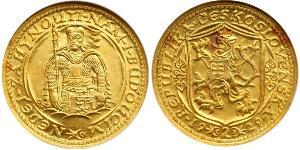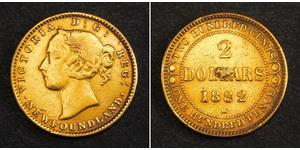1 Ducat Papal States (752-1870) Gold
Gold Zecchino Ducat Coin.
Mint Period: 1400-1413 AD
Mint Place: Chios (Genoese occupation)
Reference: Friedberg 1230 var. (for the Venetian type), Friedberg 2d (Chios), Gamberini 395 (Chios/La Maona).
Denomination: Zecchino (Venetian Ducat) - issued in the name of Michele Steno
Diameter: 22mm
Material: Gold!
Weight: 3.49gm
Obverse: St. Mark standing right, presenting cross topped bannerto kneeling Doge.
Legend: Mih · AEIS · T · E · - S/M/M/E/M/·/T/I
Reverse: Christ standing facing, raising hand in benediction and holding Gospels.
Comment: Halo of light (mandorla) with 9 stars around.
Legend: SI · T T · XIE RX T · V S - · IEEISTE DVKVT
Chios is the fifth largest of the Greek islands, situated in the Aegean Sea, seven kilometres (five miles) off the Asia Minor coast. The island is separated from Turkey by the Chios Strait. The island is noted for its strong merchant shipping community, its unique mastic gum and its medieval villages.
After the permanent division of the Roman Empire in 395 AD, Chios was for six centuries part of the Byzantine Empire. This came to an end when the island was briefly held (1090–97) by Çaka Bey, a Turkish emir in the region of Smyrna during the first expansion of the Turks to the Aegean coast. However, the Turks were driven back from the Aegean coast by the First Crusade, and the island reverted to Byzantine rule.
This relative stability was ended by the sacking of Constantinople during the Fourth Crusade (1204) and during the turmoil of the 13th century the island ownership was constantly affected by the regional power struggles.
After the Fourth Crusade, the Byzantine empire was divided up by the Latin emperors of Constantinople, with Chios nominally becoming a possession of the Republic of Venice. However, defeats for the Latin empire resulted in the island reverting to Byzantine rule in 1225.
Through the Treaty of Nymphaeum the authority of Chios was ceded to the Republic of Genoa (1261). At this time the island was frequently attacked by pirates and by 1302–1303 was a target for the renewed Turkish fleets. To prevent Turkish expansion, the island was reconquered and kept as a renewable concession, at the behest of the Byzantine emperor Andronicus II, by the Genovese Benedetto I Zaccaria (1304), then admiral to Philip of France. Zaccaria installed himself as ruler of the island, in the short-lived Lordship of Chios. His rule was benign and effective rule remained in the hands of the local Greek landowners. Beneto Zacharia was followed by his nephew (Benedetto II) and then son (Martino). They attempted to turn the island towards the Latin and Papal powers, and away from the predominant Byzantine influence. The locals, still loyal to the Byzantine Empire, responded to a letter from the emperor and, despite a standing army of a thousand infantrymen, a hundred cavalrymen and two galleys, expelled the Zacharia family from the island (1329) and dissolved the fiefdom.
Local rule was brief. In 1346, a Chartered company or Maona (the “Maona di Chio e di Focea”) was set up in Genoa to reconquer and exploit Chios and the neighbouring town of Phocaea in Asia Minor. Although the islanders firmly rejected an initial offer of protection, the island was invaded by a Genoese Fleet, led by Simone Vignoso, and the castle besieged. Again rule was transferred peacefully, as on 12 September the castle was surrendered and a treaty signed with no loss of privileges to the local landowners as long as the new authority was accepted.
The Genoese, being interested in profit rather than conquest, controlled the trade-posts and warehouses, in particular the trade of mastic, alum, salt and pitch. Other trades such as grain, wine oil and cloth and most professions were run jointly with the locals. After a failed uprising in 1347, and being heavily outnumbered (less than 10% of the population in 1395), the Latins maintained light control over the local population, remaining largely in the town and allowing full religious freedom. In this way the island remained under Genoese control for two centuries.
By the early 15th century, Asia Minor and the surrounding islands had fallen under Ottoman rule, however the Genoese families managed to maintain control over the island through the payment of a tribute to the Sultan. By the 16th century, as Genoese power waned, trade with Genoa had decreased and the local rulers become assimilated into the local population.
This largely independent rule of Genoese families continued until 1566, when, with tensions rising, the Sultan decided that the island could potentially be used as a base for Western attacks on Constantinople. The island was invaded by Ottoman troops and absorbed into the Ottoman Empire. Consequently, Greek Phanariotes gradually replaced these Genoese families as a protectorate of Chios and maintained relative autonomy despite the Ottoman occupation.
View all coins in the group
(3205 X 1560 pixels, file size: ~1M)
Posted by: anonymous 2023-10-29
1439, Papal States, Roman Senate. Gold Ducat (Zecchino) Coin. (3.48gm) NGC AU58! Mint Period: 1350-1439 AD State: Vatican, Roman Senate (1st Period) Condition: Certified and graded by NGC as AU-58! Reference: Friedberg 2, Muntoni 129, MIR 179/23. Scarce! Denomination: Ducat (immitat ...
(3205 X 1560 pixels, file size: ~795K)
Posted by: anonymous 2023-10-29
1439, Papal States, Roman Senate. Gold Ducat (Zecchino) Coin. (3.5gm) NGC MS-64! Mint Period: 1350-1439 AD State: Vatican, Roman Senate (1st Period) Condition: Certified and graded by NGC as MS-64! Reference: Friedberg 2, Berman 149, Biaggi 2125. Rare! Denomination: Ducat (immitati ...
(1537 X 737 pixels, file size: ~228K)
Posted by: anonymous 2018-03-11
1400, Doges of Venice, Michele Steno. Certified Gold Zecchino Ducat. PCGS AU+ Mint Period: 1400-1413 Doge: Michele Steno (1400-1413) Denomination: Zecchino (Venetian Ducat) Reference: Gamberini 137, Friedberg 1320. R! Condition: Certified by PCGS as AU (Details: Cleaned!) Weight: ca. ...
(3205 X 1560 pixels, file size: ~821K)
Posted by: anonymous 2024-03-12
1439, Papal States, Roman Senate. Gold Ducat (Zecchino) Coin. (3.5gm) NGC MS-64! Mint Period: 1350-1439 AD State: Vatican, Roman Senate (1st Period) Condition: Certified and graded by NGC as MS-64! Reference: Friedberg 2, Berman 149, Biaggi 2125. Rare! Denomination: Ducat (immitati ...
(1077 X 489 pixels, file size: ~113K)
Posted by: anonymous 2016-01-08
1368, Greece, Island of Chios (under Genoa). Gold Zecchino Ducat Coin. 3.49gm! Mint Period: 1400-1413 AD Mint Place: Chios (Genoese occupation) Reference: Friedberg 1230 var. (for the Venetian type), Friedberg 2d (Chios), Gamberini 395 (Chios/La Maona). RR! Condition: A nicely st ...
(2311 X 1129 pixels, file size: ~615K)
Posted by: SeVeR 2016-01-18
Italy,Gold,1400-1413,Ct.Mark ctanding right presenting banner to kneeling Doge.,Christ standing facing, holding gospels and raising hand in benediction, surrounded by mandorla and stars.,
|
5 Cent Kingdom of the Netherlands (1815 - ) Bronze
group has 7 coins / 7 prices
⇑
2 Dollar Canada Gold Victoria (1819 - 1901)
group has 39 coins / 38 prices
⇑

-500-250-dWUKbzbiiLMAAAFLXT36Agf_.jpg)
-300-150-lkgBwfuW778AAAGLIB5rgHlL.jpg)
-300-150-DD2BwfuW510AAAGL8SJrgH2H.jpg)
-300-150-y1EKqUpYPYMAAAFifsms7xOl.jpg)
-300-150-RmesHgTyhRIAAAGOEtcHkTUI.jpg)
-300-150-RPQKbzbihcIAAAFSVfIQBx_U.jpg)
-300-150-OWIKbzbiTLoAAAFS97k3BlQB.jpg)






-300-150-VITBwcI0OHQAAAEqPTlDRaZv.jpg)








